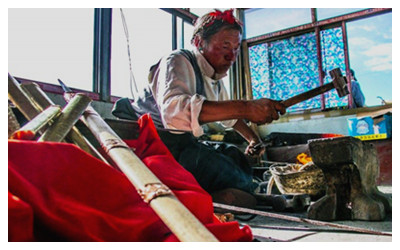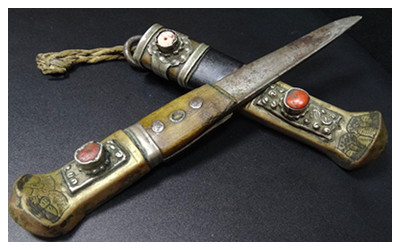Skype: neodalle-travel
Tel: +86 135 7447 2266
E-mail: sales@visitaroundchina.com
Tibetan knife with delicate carvings and exquisite silver ornaments on the sheath may not only be used for cutting meat and self-defense, but can also serve as a special decoration. It is a personal necessity for all people regardless of age and sex among the Tibetan people. Yak is the best friend of the Tibetan people and is honored as a beautiful sacred animal by the tibetan people. The yak bone, as a kind of unique adornment, has the characteristics of primitive nature, bold and vigorous thus can add a kind of feral charm to the wearer!
Purpose of Tibetan Knives
 Most exquisite Tibetan knives come from the hands of skilled craftsmen. Due to the delicate forging, delicate engraving, eye-catching colors, and Tibetan language, forming unique Tibetan crafts. And the Tibetan scripts and patterns on the scabbard and the handle of the knives also represent the blessings of auspiciousness, safe and blessed. So especially when a friend moves, marries, or has a newborn baby, sending the Tibetan knife will make the owner extremely happy. Tibetans will receive their first Tibetan knife when they are seven years old, and Tibetan knives are often used as a gift for newborn babies.
Most exquisite Tibetan knives come from the hands of skilled craftsmen. Due to the delicate forging, delicate engraving, eye-catching colors, and Tibetan language, forming unique Tibetan crafts. And the Tibetan scripts and patterns on the scabbard and the handle of the knives also represent the blessings of auspiciousness, safe and blessed. So especially when a friend moves, marries, or has a newborn baby, sending the Tibetan knife will make the owner extremely happy. Tibetans will receive their first Tibetan knife when they are seven years old, and Tibetan knives are often used as a gift for newborn babies.
In the lives of Tibetans, Tibetan knives have four purposes: production tools, life tools, self-defense weapons, and adornments. Initially, Tibetan knives were tools for the production, life, and defense tools on the snowy plateau during the long-term wild nomadic state. With the adaptation and improvement of outdoor defense and living environment, Tibetan knives have evolved into special products with aesthetic values in craftsmanship and gradually formed a custom of taking a Tibetan knife as an accessory.
Types of Tibetan Knife
From the size and length, the Tibetan knife can be divided into three types: long knife, short knife, and small knife. The longest long knife is more than one meter, the short knife is about forty centimeters long, and the small knife is only about ten centimeters long. From the usage, there are also lots of types, such as special tree cutters, slaughter knives, even the specially made cutters used on celestial burial grounds.
 Tibetan knife can be roughly divided into four parts in terms of styles: anterior Tibet and Ü-Tsang area, Gongbu area (Nyingchi area in eastern Tibet), Amdo area, and Kham area.
Tibetan knife can be roughly divided into four parts in terms of styles: anterior Tibet and Ü-Tsang area, Gongbu area (Nyingchi area in eastern Tibet), Amdo area, and Kham area.
The most well-known Tibetan knives of Lhaze and Nanmulin are representatives of Tibetan knives in anterior Tibet and Ü-Tsang area. They are known for their "sharpness". From sheath to handle, the knives are almost entirely made of metal, mainly in silver and iron, with less jewelry.
In the Kongbo area of Nyingchi, eastern Tibet, high mountains and dense forests were infested with beasts. Tibetan knives here are the most commonly used in hunting, and they are a sharp weapon for breaking through brambles and thorns. The scabbard is mostly made of wood and wrapped in animal skin. The decoration is mainly the coat color and toe claws attached to the animal skin. The handle is usually inlaid with sharkskin or black ox horns, which are easy to hold and not easy to slip off.
Amdo is pastoral areas, and the knives here are mainly used for slaughtering and cutting meat. Amdo people like jewelry accessories, so their knife handles and scabbards are usually inlaid with gold, silver, turquoise, coral, and agate, shining like exquisite artworks.
The people in Kham are bold and unconstrained. They love combat knives more than their cattle and sheep. So they require the knives not only attractive but also deterrent. The scabbard is generally made of yellow, white copper or sterling silver, inlaid with jewelry and engraved with exquisite patterns and symbols. The knives here are also used technologies such as reliefs, hollowing, and other processes, which make the knives magnificent and imposing.
Tibetan knife has a history of over 1600 years ago. It's not only an indispensable tool in Tibetan people’s life but also an important part of Tibetan culture. Tibetan knife has a high reputation because of its shape, craft as well as unique national characteristics at home and abroad. Even when describing the characteristics of the Tibetan, people always associate Tibetans with knives. Nowadays, the Tibetan knife is a very popular tourist commodity and gift loved by people.
 Ask Questions ?
Ask Questions ?